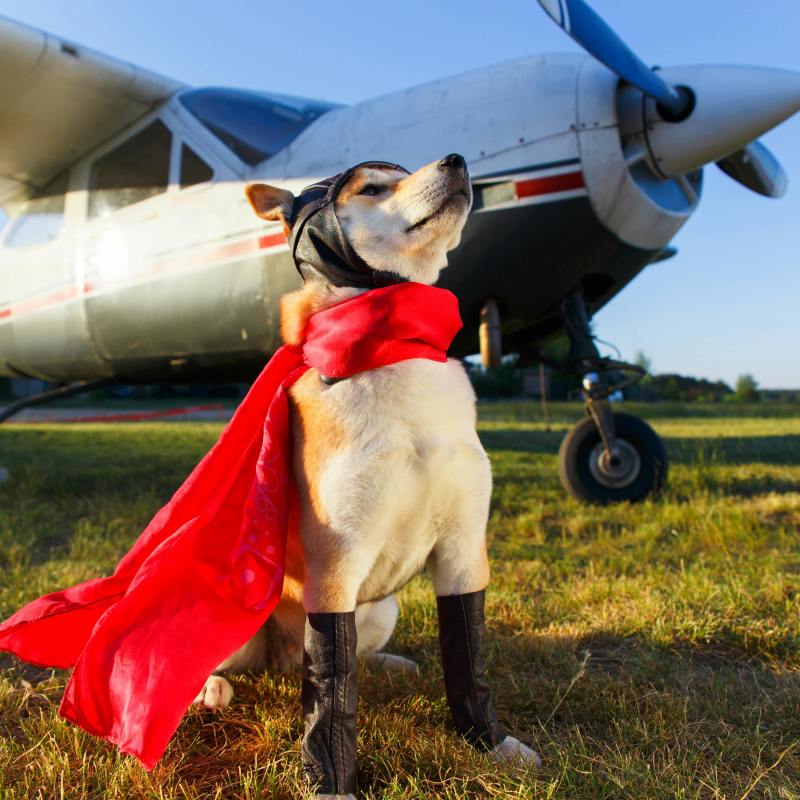
One of the toughest parts of travel is leaving our beloved dogs behind.
Videos by TravelAwaits
I could be staring at a wonder like the Northern Lights or the Grand Canyon when, in a split second, my mind drifts to my little chihuahua. Suddenly, I’m removed from the experience, wondering how my dog is faring without me back home.
After all, the best way to travel is with a pet.
Hitting the road with Fido is a beautiful experience that exposes your dog to new wonders while also deepening your bond. Still, as someone who has flown across the Atlantic with a dog, traveled long distances by train with a dog, and driven cross-country with a dog, I know first-hand that it’s not for the faint of heart.
Flights can be especially trying.
Even when everything goes right, it takes mindfulness, care, and forethought to get you and your furry friend to your destination without incident.
The first question that pet parents need to ask before booking tickets is:
Is your dog ready to fly?
To answer that question, I’ve enlisted the help of one of the world’s most trusted and expansive pet-sitting and pet-care platforms: Rover.
Here’s what you need to know about flying with a dog, according to expert panelist and certified professional dog trainer Nicole Ellis.
Is your dog ready to fly? Here’s what Ellis has to say
What are some signs that your dog is ready for a flight?
According to Ellis, dogs that do well during car rides might also do well on planes—but there’s no fast and clear answer. All pet parents must recognize their dog’s unique predispositions.
However, generally speaking, the better they do with travel (in cars, trains, etc), the more likely they are to handle a flight well.
What are some signs they might struggle on a flight?
If your dog is easily stressed out or anxious during long car rides, they might not be ready to take flight with you. Similarly, dogs who aren’t comfortable and calm in their carriers aren’t likely to do well on a plane.
Remember—dogs usually need to stay inside a carrier the whole time. Even in the case of airlines that allow dogs to occupy a seat, your pup should be calm for the duration of the flight.
How do you know if your dog should go on the trip?
According to Ellis, pet parents should also think long and hard about why they’re bringing their pup 35,000 feet into the air.
In my case, I traveled domestically in the US and internationally with my chihuahua because I was moving around a lot—not because I wanted my dog to tag along on a particular adventure with me.
So, how should you know if your dog wants to travel with you? Here are some thoughts to consider. First, will your dog enjoy the destination? A dog that lives in the country might not enjoy a trip to the big city. Simultaneously, many attractions don’t allow dogs.
If there isn’t a concrete reason for your dog to travel with you, then it’s best to avoid flying with them.
Is it safe for dogs to go into the cargo hold?
Ellis advises using extreme caution when putting pets into the cargo hold. If you have a snub-nosed (brachycephalic) dog like a Frenchie or a pug, it could be dangerous. The same is true for senior dogs and dogs that are prone to anxiety.
In these cases, your pet is probably better off at home. (With a Rover sitter, nonetheless.)
Are there any dog breeds that perform better or worse on flights?
The most important thing to keep in mind before making the decision to fly with your dog isn’t solely about breed—it’s also about their character.
Pet parents should be honest about whether or not their dog will do well on a plane. On top of that, Ellis advises that pet parents invest in training beforehand. Dogs on planes must be calm, obedient, and comfortable.
How do you handle bathroom breaks while flying?
According to Ellis, the best way to prepare for bathroom breaks is to research pet relief areas at your departing airport and destination. Pet parents should be taking their pooch to the potty right before a flight and directly after a flight lands.
Ellis also recommends wiping down paws after using these areas. Because so many pets use the relief area in a day, it’s sanity to wipe down your pup.
Flight prep for your pup
Is your dog ready to fly? If you answered yes, then here’s how you can expect to prep for the big day:
- Invest in dog training so that your pup is obedient and also has a positive relationship to their carrier.
- Evaluate your dog’s character along with their training level to determine whether they’ll do well on a plane.
- After booking tickets, research pet relief areas at the departing and destination airports.
- Use products like a ThunderShirt and a calming pheromone spray to set your pup up for success at the airport.
- Before boarding, take them to go potty at the nearest pet relief area.
- After landing, immediately head to the pet relief area.
- If traveling internationally, visit the necessary in-airport veterinarian office for a health check-up.
